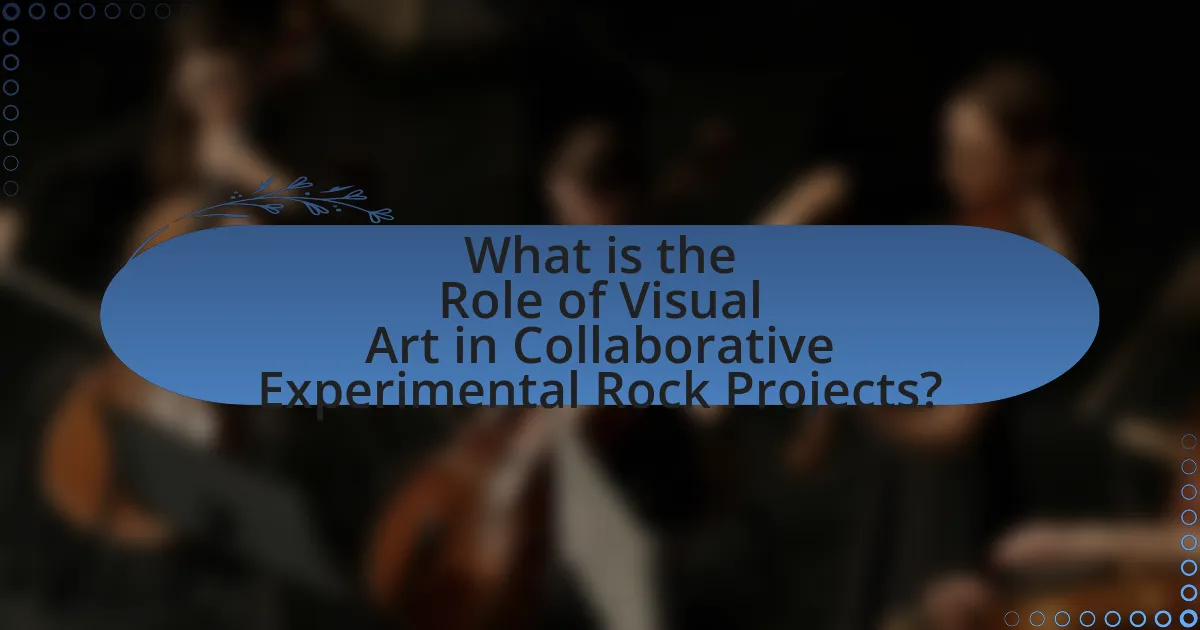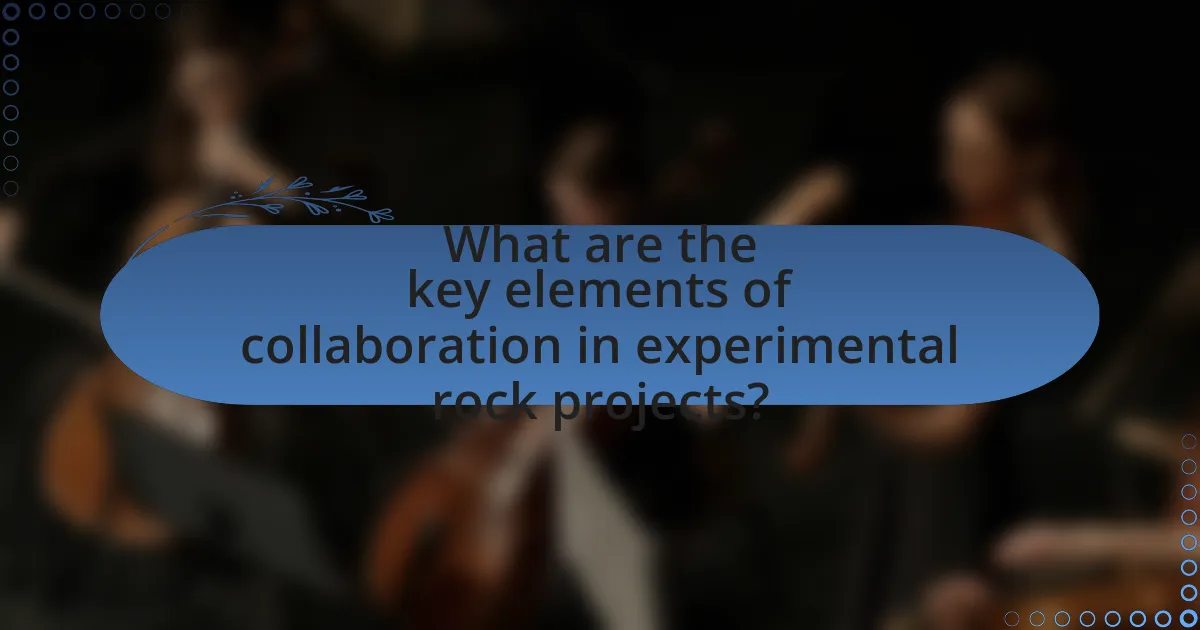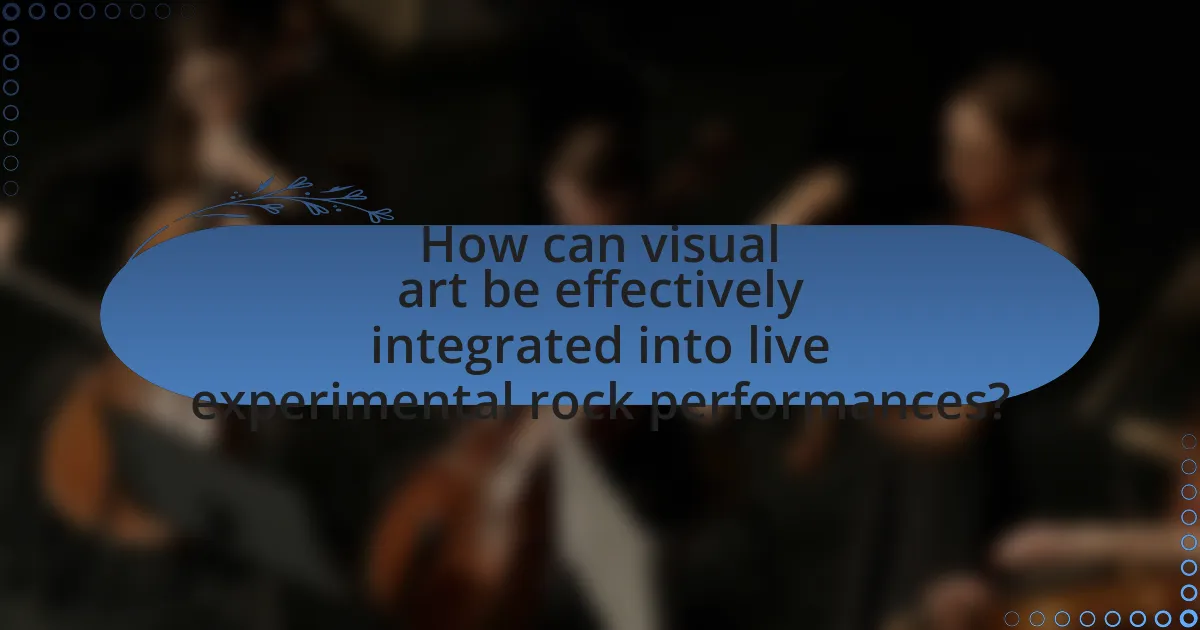The article examines the integral role of visual art in collaborative experimental rock projects, highlighting how it enhances the aesthetic experience and provides a visual narrative that complements music. It discusses the influence of visual art on the creative process, the specific forms of visual art commonly integrated, and the methods of collaboration between musicians and visual artists. Additionally, the article addresses the emotional and thematic contributions of visual art, the challenges faced in collaboration, and best practices for maintaining creative harmony. Key examples, such as the collaborations of Pink Floyd and Björk, illustrate the successful integration of visual elements in live performances, emphasizing the importance of technology and communication in these artistic endeavors.

What is the Role of Visual Art in Collaborative Experimental Rock Projects?
Visual art plays a crucial role in collaborative experimental rock projects by enhancing the overall aesthetic experience and providing a visual narrative that complements the music. This integration of visual elements, such as album artwork, stage design, and music videos, helps to create a cohesive artistic vision that engages audiences on multiple sensory levels. For instance, the collaboration between musicians and visual artists can lead to innovative performances that incorporate multimedia elements, as seen in projects like Pink Floyd’s “The Wall,” where visual art was integral to the storytelling and emotional impact of the music. This synergy not only enriches the listener’s experience but also fosters a deeper connection between the artists and their audience, making visual art an essential component of the collaborative process in experimental rock.
How does visual art influence the creative process in experimental rock music?
Visual art significantly influences the creative process in experimental rock music by providing a visual framework that inspires musicians and shapes their sound. This influence manifests through album artwork, stage design, and multimedia performances, which can evoke emotions and concepts that inform the music’s composition and arrangement. For instance, the collaboration between musicians and visual artists, such as the partnership between Pink Floyd and artist Storm Thorgerson, demonstrates how visual elements can enhance the thematic depth of an album, as seen in the iconic cover of “The Dark Side of the Moon.” This synergy between visual art and music not only enriches the listening experience but also encourages innovative approaches to sound, leading to the exploration of new genres and styles within experimental rock.
What specific visual art forms are commonly integrated into these projects?
Collaborative experimental rock projects commonly integrate visual art forms such as multimedia installations, video art, performance art, and graphic design. These art forms enhance the auditory experience by providing a visual context that complements the music. For instance, multimedia installations often combine sound and visual elements to create immersive environments, while video art can be synchronized with live performances to engage audiences on multiple sensory levels. Graphic design is frequently used in album artwork and promotional materials, establishing a cohesive aesthetic that reflects the project’s themes and concepts.
How do artists collaborate to merge visual art with music?
Artists collaborate to merge visual art with music by integrating multimedia elements that enhance the auditory experience. This collaboration often involves visual artists creating artwork that complements or responds to musical compositions, such as album covers, stage designs, and live visual projections. For instance, the band Pink Floyd famously collaborated with visual artist Storm Thorgerson, whose iconic album covers visually represented the themes of their music, thereby creating a cohesive artistic vision. Additionally, live performances frequently feature synchronized visual displays that interact with the music, exemplified by the use of video art in concerts by artists like Björk, who employs visual storytelling to deepen the audience’s engagement with her music.
Why is visual art important in the context of collaborative experimental rock?
Visual art is important in the context of collaborative experimental rock because it enhances the overall sensory experience and deepens the emotional connection between the audience and the music. The integration of visual elements, such as album artwork, stage design, and multimedia performances, creates a cohesive artistic expression that complements the innovative soundscapes typical of experimental rock. For instance, bands like Pink Floyd have historically used visual art in their live shows, employing elaborate light displays and projections that amplify the themes of their music, thereby enriching the listener’s experience. This synergy between visual art and music not only captivates audiences but also fosters a collaborative environment where artists from different disciplines can contribute their unique perspectives, ultimately pushing the boundaries of creativity within the genre.
What emotional or thematic elements does visual art contribute to the music?
Visual art contributes emotional and thematic elements to music by enhancing the overall sensory experience and deepening the narrative conveyed through sound. For instance, visual art can evoke specific emotions such as nostalgia, joy, or melancholy, which can be reflected in the music’s tone, tempo, and instrumentation. The integration of visual elements, such as album covers or stage design, often aligns with the themes present in the music, creating a cohesive artistic statement. Research indicates that visual stimuli can significantly influence listeners’ emotional responses, as demonstrated in studies showing that album artwork can alter perceptions of musical genres and emotional content. This synergy between visual art and music not only enriches the audience’s experience but also allows artists to communicate complex themes more effectively.
How does visual art enhance audience engagement during performances?
Visual art enhances audience engagement during performances by creating a multisensory experience that captivates viewers and deepens their emotional connection to the music. This integration of visual elements, such as projections, installations, or live painting, stimulates the audience’s senses, making the performance more immersive. Research indicates that visual stimuli can increase attention and retention, as evidenced by a study published in the journal “Psychological Science,” which found that visual aids significantly improve memory recall in performance settings. By combining auditory and visual elements, artists can evoke stronger emotional responses, leading to a more memorable and impactful experience for the audience.

What are the key elements of collaboration in experimental rock projects?
The key elements of collaboration in experimental rock projects include shared creative vision, diverse skill sets, open communication, and mutual respect among collaborators. A shared creative vision ensures that all participants are aligned in their artistic goals, which is crucial for cohesive project development. Diverse skill sets bring unique perspectives and expertise, enhancing the overall creativity and innovation of the project. Open communication facilitates the exchange of ideas and feedback, allowing for iterative improvements and adjustments. Lastly, mutual respect fosters a positive working environment, encouraging all collaborators to contribute freely and confidently. These elements are essential for the successful execution of experimental rock projects, as evidenced by numerous collaborations in the genre that have resulted in groundbreaking music and art.
How do musicians and visual artists communicate their ideas?
Musicians and visual artists communicate their ideas through collaborative projects that integrate sound and visual elements, enhancing the overall artistic expression. For instance, musicians may use visual art to create album covers, stage designs, or music videos that visually represent the themes and emotions of their music. Conversely, visual artists may draw inspiration from musical compositions, using sound as a catalyst for their visual creations. This synergy is evident in experimental rock projects, where the interplay between audio and visual components can evoke a more profound emotional response from the audience. Historical examples include the collaboration between Pink Floyd and artist Storm Thorgerson, whose iconic album covers visually encapsulated the band’s music, demonstrating how visual art can amplify and communicate musical ideas effectively.
What tools and platforms facilitate collaboration between artists?
Tools and platforms that facilitate collaboration between artists include digital platforms like Adobe Creative Cloud, which offers tools for graphic design, video editing, and collaboration through shared projects. Additionally, platforms such as SoundCloud and Bandcamp enable musicians to share their work and collaborate on audio projects. Social media platforms like Instagram and Facebook also serve as networking tools, allowing artists to connect and collaborate on visual and performance art. Collaborative project management tools like Trello and Asana help artists organize their workflows and communicate effectively. These tools enhance creative collaboration by providing shared resources and communication channels, which are essential for successful artistic partnerships.
How do differing artistic visions impact the final outcome of a project?
Differing artistic visions significantly impact the final outcome of a project by influencing creative direction, collaboration dynamics, and the overall aesthetic. When artists have distinct visions, it can lead to innovative blends of styles, resulting in unique and compelling works that may not have emerged from a singular perspective. For instance, in collaborative experimental rock projects, the integration of various artistic viewpoints can enhance the richness of the music and visual elements, creating a more immersive experience for the audience. This phenomenon is supported by examples such as the collaboration between musicians and visual artists in projects like “The Wall” by Pink Floyd, where the interplay of differing artistic ideas contributed to the project’s iconic status.
What challenges do artists face in collaborative projects?
Artists face several challenges in collaborative projects, including differing creative visions, communication barriers, and logistical issues. Differing creative visions can lead to conflicts over artistic direction, as each artist may have unique ideas about the project’s aesthetic and goals. Communication barriers often arise from varying levels of experience and artistic language, which can hinder effective collaboration. Logistical issues, such as coordinating schedules and resources, can also complicate the collaborative process. These challenges are documented in studies on collaborative art practices, highlighting the importance of clear communication and shared objectives to mitigate conflicts and enhance creative synergy.
How can conflicts in creative direction be resolved?
Conflicts in creative direction can be resolved through open communication and collaborative decision-making. Establishing a clear dialogue among team members allows for the expression of differing viewpoints and fosters mutual understanding. Techniques such as brainstorming sessions, where all ideas are welcomed, can help in finding common ground. Additionally, involving a neutral third party to mediate discussions can provide an unbiased perspective, facilitating compromise. Research indicates that teams that prioritize communication and collaboration are more successful in overcoming creative conflicts, as evidenced by studies showing improved project outcomes when diverse opinions are integrated effectively.
What logistical issues arise when combining visual art and music?
Combining visual art and music presents logistical issues such as synchronization of timing, space requirements, and resource allocation. Synchronization is crucial as visual elements must align with musical cues, which can complicate rehearsals and performances. Space requirements arise from the need for appropriate venues that can accommodate both art installations and musical performances, often necessitating larger or specially designed spaces. Resource allocation involves managing budgets and materials for both art and music, which can strain financial and logistical planning. These factors highlight the complexities involved in effectively merging these two art forms in collaborative experimental rock projects.

How can visual art be effectively integrated into live experimental rock performances?
Visual art can be effectively integrated into live experimental rock performances through the use of multimedia projections, interactive installations, and synchronized visual elements that enhance the musical experience. By employing techniques such as real-time video manipulation and immersive environments, artists can create a cohesive narrative that complements the soundscapes of the performance. Historical examples include the use of visual projections by bands like Pink Floyd, which transformed their concerts into multi-sensory experiences, demonstrating that visual art can significantly elevate audience engagement and emotional response.
What techniques are used to synchronize visual art with live music?
Techniques used to synchronize visual art with live music include real-time video projection, interactive installations, and the use of software that responds to audio signals. Real-time video projection allows artists to create visuals that change in response to the music, enhancing the overall experience. Interactive installations enable audience participation, where visuals are influenced by the movements or actions of the viewers, creating a dynamic relationship between sound and sight. Additionally, software like Max/MSP or TouchDesigner can analyze audio frequencies and trigger corresponding visual elements, ensuring that the visuals are tightly aligned with the musical performance. These methods have been employed in various collaborative experimental rock projects, demonstrating their effectiveness in creating immersive experiences.
How does technology play a role in enhancing visual presentations during performances?
Technology significantly enhances visual presentations during performances by enabling dynamic and interactive elements that engage audiences. For instance, the use of projection mapping allows artists to transform surfaces into vibrant visual displays, creating immersive environments that complement live music. Additionally, real-time visual effects generated by software can synchronize with audio, enhancing the overall sensory experience. Research indicates that performances incorporating advanced technology, such as LED screens and augmented reality, can increase audience retention and emotional response, as evidenced by studies showing that 70% of attendees report a more memorable experience when visuals are integrated effectively.
What are some examples of successful visual art integration in live shows?
Successful visual art integration in live shows includes the use of immersive projections in performances by bands like Pink Floyd, where synchronized visuals enhance the musical experience. Another example is Björk’s Biophilia tour, which featured interactive digital installations that responded to the music, creating a multi-sensory environment. Additionally, the collaboration between Radiohead and visual artist Tarik Barri during their live performances showcased real-time visual manipulation that complemented the band’s soundscapes. These instances demonstrate how visual art can significantly elevate the audience’s engagement and emotional response during live performances.
What best practices should artists follow for successful collaboration?
Artists should prioritize clear communication for successful collaboration. Establishing open dialogue ensures that all participants understand each other’s visions, goals, and expectations. Regular check-ins and feedback sessions can help maintain alignment and address any issues promptly. Additionally, defining roles and responsibilities at the outset prevents misunderstandings and fosters accountability among collaborators. Research indicates that effective communication and role clarity significantly enhance team performance in creative projects, as evidenced by studies in collaborative art practices.
How can artists establish a shared vision from the outset?
Artists can establish a shared vision from the outset by engaging in open communication and collaborative brainstorming sessions. This approach allows all participants to express their ideas, preferences, and artistic goals, fostering a sense of ownership and alignment. Research indicates that collaborative projects benefit from clearly defined roles and responsibilities, which can enhance the cohesiveness of the artistic vision. For instance, a study published in the Journal of Creative Behavior highlights that teams with a shared understanding of their objectives are more likely to produce innovative outcomes. By prioritizing dialogue and mutual understanding, artists can effectively create a unified vision that guides their collaborative efforts.
What strategies can be employed to maintain creative harmony throughout the project?
To maintain creative harmony throughout a collaborative experimental rock project, establishing clear communication channels among team members is essential. This strategy ensures that all participants can express their ideas and concerns openly, fostering an environment of trust and collaboration. Regular meetings and feedback sessions can facilitate this communication, allowing for the alignment of artistic visions and goals. Additionally, defining roles and responsibilities helps to clarify expectations, reducing potential conflicts and misunderstandings. Research indicates that teams with well-defined roles experience higher levels of satisfaction and productivity, as seen in studies on collaborative creativity in music projects. By implementing these strategies, creative harmony can be effectively sustained throughout the project.